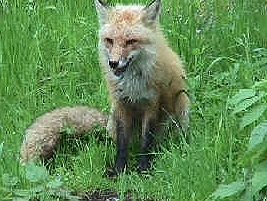
Red Fox
Vulpes vulpes
Status
Native to Newfoundland and Labrador.
Habitat
Prefer areas of semi-open country (farms, natural forest clearings, tundra and river valleys).
Range
Found in all Provinces and Territories of Canada.
Food
Their diet consists mainly of small mammals (such as voles, lemmings, squirrels, hares, rabbits, and mice) in fall and winter; augmented in Spring with nesting waterfowl and in summer with berries and plants. They are also known to eat young birds, eggs and lake trout.
Red foxes bury or hide food for later use. They hunt by smell, sight and sound (as do most dogs). Excellent eyesight and the slight movement of an ear may be all they need to locate a hidden rabbit. A red fox can hear a tunneling mouse underground and dig to find it. They hunt mostly toward sunset, during night and early morning.
Predators/Threats
Humans maybe considered the Red Fox’s greatest predator. They are sometimes considered pests for attacking poultry farms. Wolves, coyotes, bobcats, lynxes and cougars are also predators.
Lifespan
Average lifespan of 3-6 years, but have been known to live up to 10 years.
Appearance
Small, dog-like animal with a pointed face and ears. They are agile and have a lightly built body, coat of lustrous long fur and a long bushy tail. Male red foxes are slightly larger than the females. The red fox generally has black on its paws, behind its ears and on its muzzle. There are white tones on its undersides, throat, and tail. Commonly red, brown and black in color. Red foxes that are more brown and darker than red are known as “cross foxes”. Red foxes that are black are called “silver foxes”.
Breeding Biology
Dog foxes (males) and vixens (females) are usually monogamous. The pair may separate during the year, but will reunite for mating. Red foxes breed in late December in warmer areas and up until March in colder climates. They may use an abandoned den of another animal, a cave, a hollow log, or an excavation under a barn or other structure. These dens sometimes have more than one entrance for escaping danger such as predators. The entrances often face south and have good visibility. The home range around the den is usually 4-8 sq. km.
The pups are blind at birth and the eyes open during the second week. For about two months they are trained to hunt and they leave the den at around three months. The young travel widely during the fall, seeking new territory. Some have been tracked over 250 km from the birth den.
Average Weight/Measurements
Adults weight (8 – 15 lbs)(3.6 – 6.8 kg) and range in length from (3 – 3.7 ft)(90-112 cm). (About one third of the fox’s length is its tail).
Notes:
- In Newfoundland and Labrador, color phases occur with the following approximate frequency: red – 65%; cross – 27%; silver – 8%.
At Salmonier Nature Park
- We currently have two red foxes on site.
